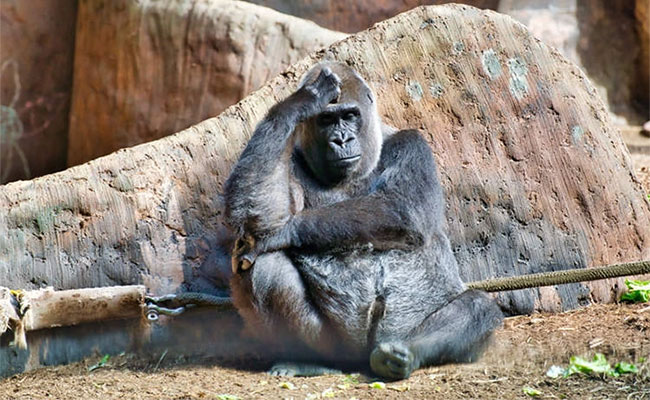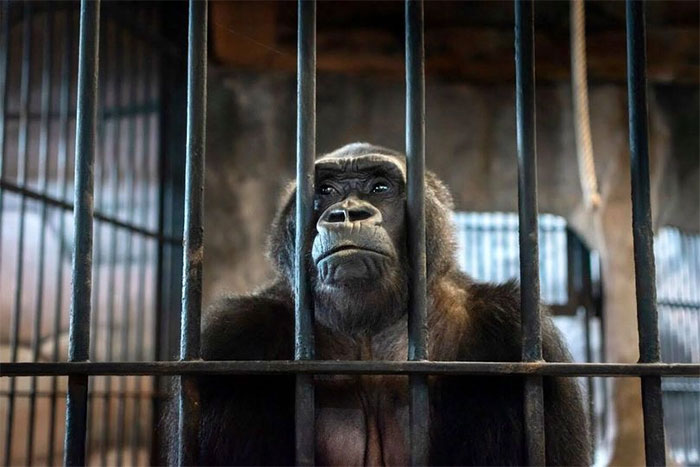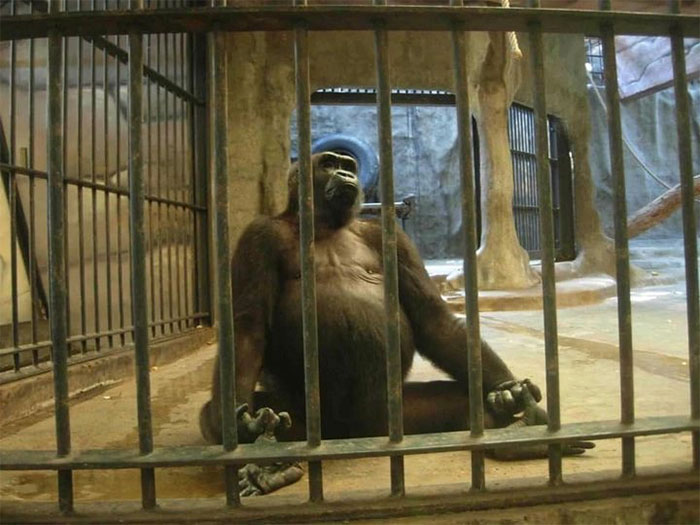A 33-year-old gorilla has spent most of its life alone in a metal cage on the 7th floor of a shopping mall in Bangkok, Thailand, earning the title of the world’s loneliest gorilla.
Bua Noi is a female gorilla who has lived alone in a shopping mall in Bangkok, Thailand, for over three decades. In fact, this is one of the main attractions of a peculiar zoo – located inside the oldest shopping center in Bangkok, Pata Pinklao Department Store.
The owners of this location have repeatedly refused to transfer her to a more suitable place, despite numerous requests from animal rights activists and the Thai government. Even today, Bua Noi’s owners still refuse to allow her to spend her remaining days in a sanctuary alongside other members of her species.

For the past 30 years, Bua Noi the gorilla has lived behind bars in a shopping mall in the Thai capital, Bangkok. Pata Zoo, located atop the Pata shopping center in Bangkok, has been labeled by animal rights organization PETA Asia as “one of the saddest places in the world” – the organization has called for the closure of this facility following an investigation earlier this year.
“This deplorable facility has been internationally condemned as one of the worst zoos in the world,” said PETA Senior Vice President Jason Baker. “I urge everyone to keep the pressure on Pata Zoo and demand that they allow PETA to help relocate these animals to reputable sanctuaries that can meet their physical and mental needs.”
The Thai Minister of Environment has also stated that he wants to see Bua Noi, whose name means “Little Lotus,” transferred to a wildlife sanctuary where she can “experience a habitat similar to her home and be with other gorillas,” but in reality, the gorilla is private property and can only be moved with the owner’s permission.

According to PETA Asia, Bua Noi was captured as a baby and taken to Pata Zoo, which has “imprisoned animals in harsh conditions” since the 1980s. Many reviews of this facility on the TripAdvisor app label it as “an animal hell.”
“Bua Noi is considered private property, so we cannot do anything to help her,” said Thanetpol Thanaboonyawat. “The owner bought Bua Noi before laws were enacted to prevent the trade and ownership of endangered and wild animals. We have raised a certain amount of money from supporters of Bua Noi. But the problem is the owner refuses to sell Bua Noi, and when he agrees to sell, the price he demands is too high.”
According to Thai sources, Bua Noi’s owner is asking for approximately $800,000 to release the gorilla, and the company that owns the zoo has refused any negotiations for the sale of the animal. A representative from the zoo insists that the gorilla is well cared for and is not experiencing physical or mental stress.

Gorillas can live 35 to 40 years in the wild and up to 50 years in captivity.
Unfortunately, despite strong international opposition, little can be done unless the zoo owner decides to allow this gorilla to retire after a lifetime of loneliness. Gorillas can live 35 to 40 years in the wild and up to 50 years in captivity. The sad story of Bua Noi recalls another tragedy we witnessed a few years ago – the heartbreaking tale of Honey, the loneliest dolphin in the world, who died alone in an abandoned water park in Japan.
Gorillas are a genus in the family Hominidae, order Primates, herbivorous animals that live in the rainforests of Africa, and are the largest remaining species in the Primates order. Gorillas are divided into two species (which may have 4 to 5 subspecies). The DNA of gorillas is 98%-99% similar to that of humans. They are closely related to humans, second only to two species of chimpanzees. This primate species has a massive body. Gorillas stand between 1.7 to 2 meters tall when upright and weigh between 180 to 200 kg. They typically walk on all fours, although they can stand on two legs. The closest relatives of gorillas are the two species of chimpanzees and humans, all members of the Hominidae family diverged from a common ancestor about 7 million years ago. The human gene sequence differs on average by 1.6% from the corresponding sequence of gorillas. Until recently, gorillas were considered a single species, with three subspecies: Western lowland gorilla, Eastern lowland gorilla, and Mountain gorilla. |


















































